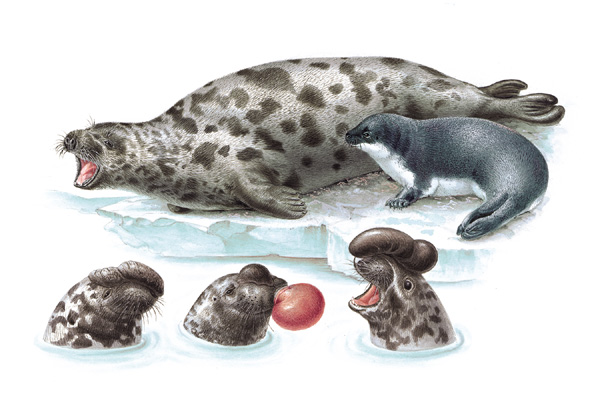Hooded Seal
From Wikipedia, the free encyclopedia
Order: Carnivora
Family: Phocidae
[Photo] Cystophora cristata - female and pup on ice floe; males in water, from left to right: normal, extruded nasal septum, and inflated hood. Credit: painting by Sandra Doyle/Wildlife Art Ltd. from Kays and Wilson's Mammals of North America, ?? Princeton University Press (2002). Source: www.mnh.si.edu/mna/image_info.cfm?species_id=57
The Hooded Seal or Crested seal, (Cystophora christata or Cystophora cristata) is an arctic seal found only in the central and western North Atlantic ranging from Svalbard in the east to the Gulf of St. Lawrence in the west.
Naming
The generic name means 'bladder-bearer' in Greek, from the peculiar inflatable appendage on the nose of the adult male. The seal is named after a cap-like bulge essay on its forehead and nose of the adult male that doesn’t hang down as with the elephant seal.
The bulge
The bulge develops when the seal is four years old. The male can blow up this bulge, so that the size of its head seems to be twice as large.
Size
Adult males are 2.6m (102in) long on average, and weigh in excess of 400kg (882lb). Sexual dimorphism is obvious from birth and females are much smaller: 2.03m (79in) long and weigh 300kg (660lb), rarely exceeding 300 kg. The colour is silvery; the body is scattered with dark, irregular marks. The head is darker than the rest of the body, and without marks.
Lifestyle
In April through June, after the breeding season, they travel long distances to feed and eventually gather together again in separate moulting areas on the ice from June through August. After moulting, they disperse widely again to feed in the late summer and autumn before returning to the breeding areas in late winter.
Breeding
There are four major breeding areas: the Gulf of St. Lawrence, the "Front" east of Newfoundland, Davis Strait (between Greenland and northern Canada) and the West Ice near Jan Mayan.
Offspring
Pups are born about 1 m long and weighing about 24 kg on the ice from mid-March to early April with a well-developed blubber layer and having shed their pre-natal coat. They are born with a slate blue-grey coat (giving them the name "blueback"), with a pale cream color on the belly, which they will moult after about 14 months. Nursing of the pup lasts for an average of only 8 days, the shortest lactation period of any mammal, during which the pup doubles in size from about 24 kg to about 47 kg.
The female pup will mature between ages 3 and 6, whereas the male pup will mature between ages 5 and 7.
Lifespan
Hooded Seals can live to about age 30 to 35.
Facts
Can stay submerged for over 50 minutes
Can dive repeatedly over 1,000 meters
http://en.wikipedia.org/wiki/Hooded_Seal
| The text in this page is based on the copyrighted Wikipedia article shown in above URL. It is used under the GNU Free Documentation License. You may redistribute it, verbatim or modified, providing that you comply with the terms of the GFDL. |
|

